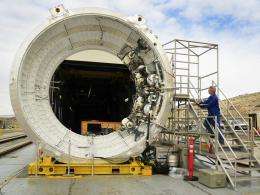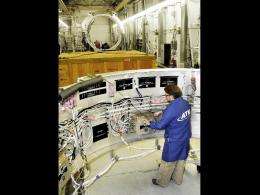Sls avionics test paves way for full-scale booster firing

(PhysOrg.com) -- NASA has successfully tested the solid rocket booster avionics for the first two test flights of the Space Launch System, America's next heavy-lift launch vehicle. This avionics system includes electrical components for the SLS' solid rocket boosters, which provide propulsion to augment the core stage main engines of the rocket. The first qualification test of the five-segment SLS booster is slated for spring 2013.
The test dubbed Flight Control Test 1, FCT-1, included heritage thrust vector control (TVC) actuators -- electro-hydraulic mechanisms previously used on the space shuttle that direct the booster propulsion system -- with a new SLS booster avionics subsystem. ATK of Brigham City, Utah, the SLS booster prime contractor for the first two test flights, conducted the test at its Promontory, Utah, test facility.
The test successfully demonstrated the new avionics subsystem's interface and control of the heritage shuttle Thrust Vector Control system and performed an SLS launch simulation. In addition to the new avionics subsystem, the test included new electronic ground support equipment which monitored and coordinated activities between the test facilities, avionics subsystem and TVC system. The test is one in a series of tests to reduce risk and demonstrate the avionics subsystem design early in the development life cycle.

"We were pleased to see how the avionics system functioned outside the lab," said Todd May, Space Launch System program manager at NASA’s Marshall Space Flight Center in Huntsville, Ala. "This test provides an insightful first look at how the booster thrust vector control system will operate and interface with flight hardware."
The booster avionics design has incorporated lean manufacturing and continuous improvement principles. For example, the design includes a common, ruggedized chassis design, 14 common programmable circuit cards and standardized cable designs.
Two additional tests are planned for the avionics and controls system.
The Space Launch System will provide an entirely new heavy-lift launch capability for human exploration beyond Earth orbit and will take crew and cargo farther into space than ever before.
More information: For images of the test and more information about SLS visit: www.nasa.gov/sls
Provided by JPL/NASA

















